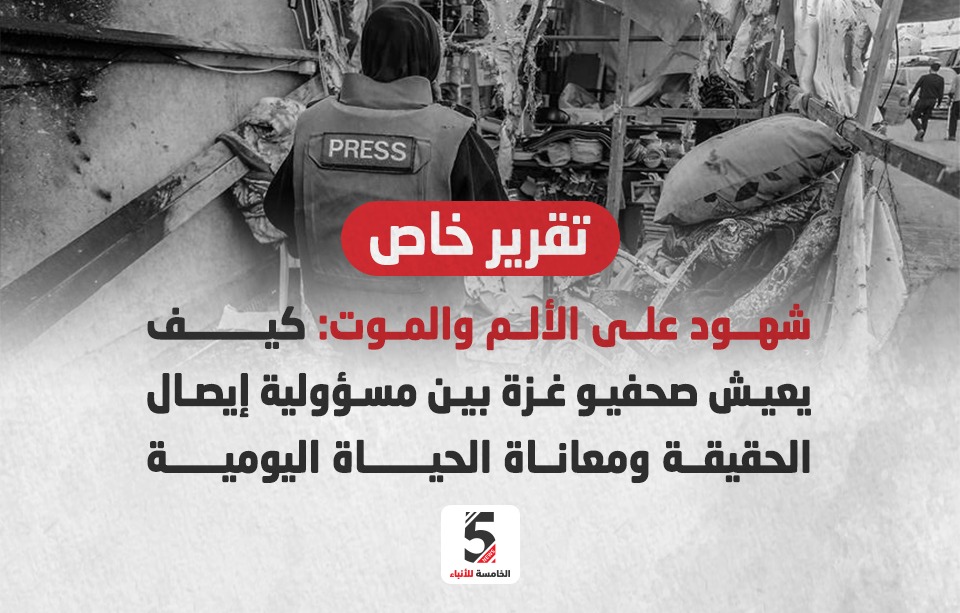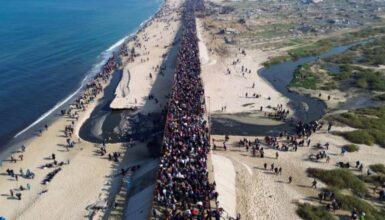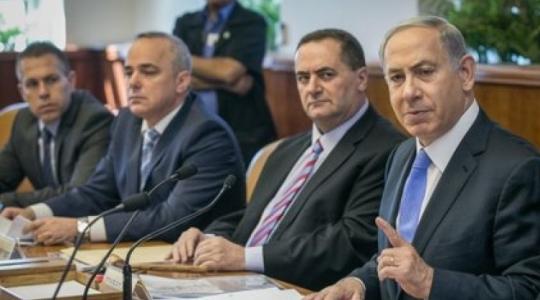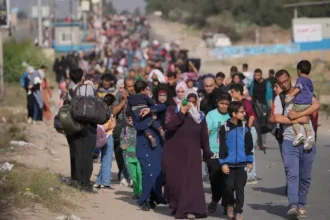Witnesses to pain and death: Gaza journalists balance duty to report with daily hardship
Al-Khamisa News Network - Gaza

Witnesses to Pain and Death.. Special report Prepared by: Wisam Ismail
In the Gaza Strip, where the bombing never stops and suffering never ends, journalists stand on the front lines, an inseparable part of the daily scene of pain experienced by residents. They do not have the luxury of separating their hearts from their lenses, nor their humanity from their profession. The journalist leaves home knowing his family may be saying goodbye for the last time. Yet he insists on carrying the voice and image of the people’s suffering to the world. Between fear and duty, they live a daily struggle: how to be sons, fathers and brothers to families awaiting their return while simultaneously witnessing the tragedy and conveying the truth whatever the cost.
In Gaza a journalist becomes a target, not just a newsbearer
Journalists endure a harsh struggle and ongoing pain. In this report prepared by the Al-Khamisa News Network, reporters recount the details of their daily lives during the war on the Gaza Strip, and the hardships and challenges they face while covering events. They convey the image of suffering experienced by all Gazans: devastating loss, hunger that eats away at bodies, and fear that accompanies them every moment.
Journalism in Gaza is not a profession but a daily gamble with death, as journalists in the Gaza Strip continue to work amid surrounding dangers and ongoing threats. They face direct targeting that places them close to death at any moment. The Israeli occupation deliberately targets them systematically, trampling international law and journalists’ rights, with more than 247 journalists documented as having been targeted while performing their work, in an attempt to obscure the picture and silence the Palestinian voice under flimsy, baseless pretexts.
Spokespeople for the occupation often offer false justifications to rationalize their crimes, linking journalists to Palestinian factions or claiming they participated in hostile acts. But this narrative collapses in light of the fact that Israeli journalists themselves appear in the field wearing body armor and military gear, revealing a stark contradiction and exposing the falsity of occupation claims.
The blood of our martyred colleagues drives me to continue
Each morning journalist Ibrahim Qanan, correspondent for Alghad TV in the Gaza Strip, leaves his displacement tent bidding his family what feels like a final farewell, carrying his camera and a message weighed down by blood and tears. Amid the sounds of shelling, communication blackouts and scarce resources, he begins his daily journey to document strikes and record hunger and suffering, while living under tremendous psychological pressure and continuous direct targeting that affects him and his colleagues.
Qanan recounts the moment he was wounded in the early days of the war, when he went out to cover events west of Rafah and was surprised by military vehicles firing at them and shells approaching with terrifying flames. He describes the field as a true killing ground — its scenes indelible — and the hardest was documenting the targeting of fellow journalists at Nasser Medical Complex live on air, an image etched in his memory like an unhealing wound.
Despite the heavy pain in his heart and memory, he insists on continuing his mission, saying: “Sometimes I think about quitting the job because of the scale of the risks, but the blood of our martyred colleagues and the suffering of children and women in Gaza push me to continue. We appear strong in front of the camera, but inside we carry indescribable pain. With every assignment I leave part of my soul with my family and carry the rest to document the truth, because the voice and image of the people are a trust upon us.”
“We are the voice of the victims… and fear never leaves us”
Journalist Noor al-Suweirki, correspondent for Al-Sharq TV, describes her state after more than 22 months of war, saying: “A journalist lives with two personalities: the journalist who struggles to convey the truth and the harsh reality amid all this fear, and the human inside his home, where the simplest things have become nearly impossible due to displacement, hardship and hunger. After the recent targeting we are in a bad mood, but we continue our role because journalism is not a passing profession; we are the voice of the people… we are the voice of the victims.”
Noor al-Suweirki says: what affects me most during coverage are the scenes of children and their suffering — decomposing bodies, amputated limbs… images no human being should ever endure, images that cannot be called humane. Every moment in the field carries more pain than the one before, and every scene remains stuck in memory and does not go away.”
She adds: “Terror accompanies us at all times, and with every missile sound calls pour in to check on us. We go out to cover events as if we are saying goodbye to our families for the last time, because of the deliberate targeting of journalists and our constant proximity to death. My greatest anxiety is to die away from my children and family, as happened to our colleague journalist Mariam Abu Daqa. The truth does not die, but fear devours our souls at every moment.”
We convey Gaza’s suffering and death chases us
Journalist Hani al-Shaer, Al Jazeera correspondent in Gaza, recounts part of his daily hardship during coverage, saying: “The occupation deliberately targets us as journalists; hundreds of us have been subjected to direct shelling, our headquarters, offices and equipment have been completely destroyed. We work with almost no resources; cameras, microphones and cars are unavailable, and the ongoing displacement has forced us to move more than ten times searching for a safe place to settle and practice our profession. But the occupation pursues us and tightens the noose everywhere.”
He adds: “We live through unbearable situations; psychological breakdown follows us with every bloody scene we see daily. We try to remain composed to convey the voice of our people who face death, hunger and displacement, but the truth is we work in an environment full of risks: repeated targeting, restrictions preventing us from reporting, and painful scenes that accompany us even in our dreams.”
He concludes with an emotional plea: “The world is not acting at the required level and does not rise to the scale of our people’s suffering. We need a serious stance to stop these violations against journalists and against all civilians. Stop the war of extermination… stop the bloodshed in Gaza… enough, enough, enough.”
I return from work weighed down by scenes that never leave my memory
Journalist Amr Tabsh wrote about his daily experience with danger and expressed in moving words his life between death and work, saying: “As a journalist in Gaza I live daily on the edge of death. When I leave my home for work or to cover an event, I bid my family as if I will never see them again… I leave the house carrying my shroud on my shoulder; I do not know if I will return alive or not.”
Tabsh describes the field as not merely a workplace but a real killing ground; the sounds of shelling follow him everywhere, and the smell of blood and gunpowder accompanies him like a heavy, persistent shadow. He says: “I don’t just cover events; I live them in all their details and pay for them psychologically and physically.”
His suffering increases when he returns home burdened by the scenes he has witnessed that do not leave him. He describes: “I see the martyred children as if they were my own, I see the grieving mothers as if they were my mother… I return weighed down by scenes that never leave my memory. I cannot sleep, and I cannot explain to anyone what is happening inside me.”
He ends with a candid admission of his fragility as a human before being a journalist: “I write now not to show my strength, but to admit my weakness… This is not a passing profession; this is a daily life full of pain and risks, and at any moment we may become the news ourselves and our lenses may become witnesses to our death.”
Witnesses to pain and death
Despite all the risks, journalists in Gaza continue their work, carrying the responsibility of conveying the truth to the world. They live every moment between fear and duty, between their profession and their families, amid repeated displacement and lack of basic equipment, all while facing direct targeting and ongoing incitement campaigns. Nevertheless, they insist that the lens remains a witness and the pen a transmitter of the voices of the voiceless.
Journalists in Gaza are not mere reporters; they are living witnesses to a humanitarian tragedy. They feel constant proximity to death and suffer daily psychological and physical pressure, yet they do not stop. Every photo, every report, every word they convey represents the cry of Gaza’s people who face death, hunger and displacement, so that the world remains confronted with the truth no matter how the occupation tries to erase it.






